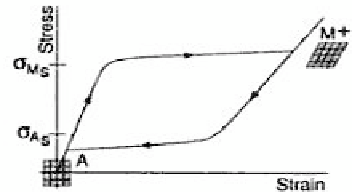Biomedical Engineering Reference
In-Depth Information
the transformation ends is denoted by
M
f
. Subsequent heating starts
reversible transformation from martensite to original symmetric
crystallographic state of austenite phase, and similarly
A
s
and
A
f
are
characteristic temperatures (Fig. 8.13).
8.4.2
Mechanically Induced Transformation
Apart from temperature dependence, phase transformation in
material can be induced by the applied loads as it has been mentioned
earlier.
At the applied mechanical load, the transformation of
the austenite structure generates only the type of martensitic
structure variants that reduce stress. When the loads are applied
to the martensitic grain structure, most favorable variants are
generated from the existing structure of different variants that lead
to the situation mentioned earlier and thus create the detwinned
form of martensite. This phenomenon is called reorientation. Also
essential in this point of discussion is to introduce the characteristic
M
d
temperature, deined as the value above the martensitic
mechanically induced transformation cannot occur; it is usually
25-50°C higher than
A
f
.
For the temperature range of thermodynamic stability of the
austenite phase, above
A
f
and beneath
M
d
during loading, nearly
linear relation between stress and strain occurs — the variants of
martensite that reduce stress are generated. When the level of
σ
Ms
is exceeded, the transformation of austenite to martensite begins.
The structure starts to accumulate energy in elongation form, which
manifests as a macroscopic change of microstructure. It undergoes
further transformation — reorientation into the detwinned form of
martensite
M
+ (Fig 8.14).
M+
σ
Ms
σ
As
A
Strain
Figure 8.14
Stress to strain relation during loading for SMA at
thermodynamic stable austenite temperature range [41].





















